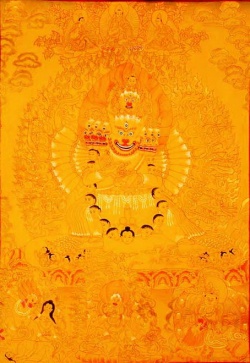Vajrabhairava Ekavira - The Yamantaka Without Consort
In powerful delineation and vibrant yellow colour is Vajrabhairava, with nine faces, thirty-four arms and sixteen feet. He is one of the most venerated deities in Tibetan Buddhism, especially among the Gelupas and Sakyapas. He is the terrific emanation of Manjushri, his wrathful aspect. He is the sacred terror so that the crowds never betray the precepts of Shakyamuni. He dominates the efficacy of spiritual achievement. He is the fusion of two aspects: the blessed aspect and the irate aspect the emanation of the double aspect of Manjushri. He is so fierce as to destroy all forces contrary to Dhamma. He is also known by the name of Yamantaka, which means the God who puts, an end to Yama. Yama signifies all evil that derives from malefic forces, and him he suppresses. Vajrabhairava is thus a god of redemption, one who fights against evil and triumphs.
There are many forms of Vajrabhairava. This painting is of Vajrabhairava Ekavira, Ekavira meaning "solitary hero", the only form who does not embrace a consort. The deity is also called Yamantaka Ekavira. He has nine faces, as mentioned above, three on each side of the main head and one above it, each with three eyes. The main head is that of a fierce buffalo with horns, imitating but even fiercer than the head of Yama, the lord of death. The small, topmost head is of Manjushri a wearing a crown of jewels. The eight other heads are wearing skull crown, and their hair rises upward, signifying the deity's enlightenment. He wears bone ornaments and the necklace of freshly cut heads. He also wears necklace of jewels with a wheel like ornament on his chest, which is not visible, as it is covered by his main hands. He has thirty-four arms, sixteen on each side plus two main arms that hold skull-bowl and chopper. His remaining hands are holding Tantra symbols.
He has sixteen legs, eight on each side. Lying under his bent right legs are one human male and seven animals that are, in turn, stepping on four heavenly gods. Under his outstretched left legs, eight birds are also stepping on four devas. He has a potbelly, naked body, and the member is in erection.
The teaching and practice of Vajrabhairava were popularized and started by the Mahasiddha Lalitavajra in eastern India around sixth century A.D. He found the sadhana in the Manjushri Root Tantra taught by Shakyamuni and the teachings were supposedly revealed to him by the dakini Dorje Rolangma, who became the consort of Vajrabhairava. It is said that from Lalitavajra, the teachings and practice passed on to several Indian scholars, then to Lama Bharo, a Nepalese Buddhist; and then to Ra Lotsawa Dorje Drags, a Tibetan lama who translated the sadhanas into Tibetan and wrote many commentaries. The practice of Vajrabhairava was very important to Tsong Khapa, who was believed to be a manifestation of Manjushri, and Vajrabhairava teachings are particularly strong among the Gelupas.
On the top, Tsong Khapa is seated on lotus throne along with his chief disciples. At the bottom, from left to right are, Dharmaraja Yama, six-armed Mahakala, and Vaishravana. The thangka is well painted , it is undoubtedly an excellent work.
Select Bibliography
A. Getty, The Gods of Northern Buddhism, Tokyo, 1961.
A. K. Gordon, The Iconography of Tibetan Lamaism, New York, 1939
Bhattacharyya, The Indian Buddhist Iconography, Calcutta, 1958
L.A . Waddell, Buddhism and Lamaism of Tibet, New Delhi, 1979 (reprint)
P. Pal, The Art of Tibet, New York, 1969
P. Pal, Art of the Himalayas: Treasures from Nepal and Tibet, New York, 1991
Marylin M. Rhie & Robert A.F. Thurman, World of Transformation: Tibetan Art of Wisdom and Compassion, New York, 1999
This description is by Dr. Shailendra K. Verma, whose Doctorate thesis is on "Emergence and Evolution of the Buddha Image (From its inception to 8th century A.D.).
